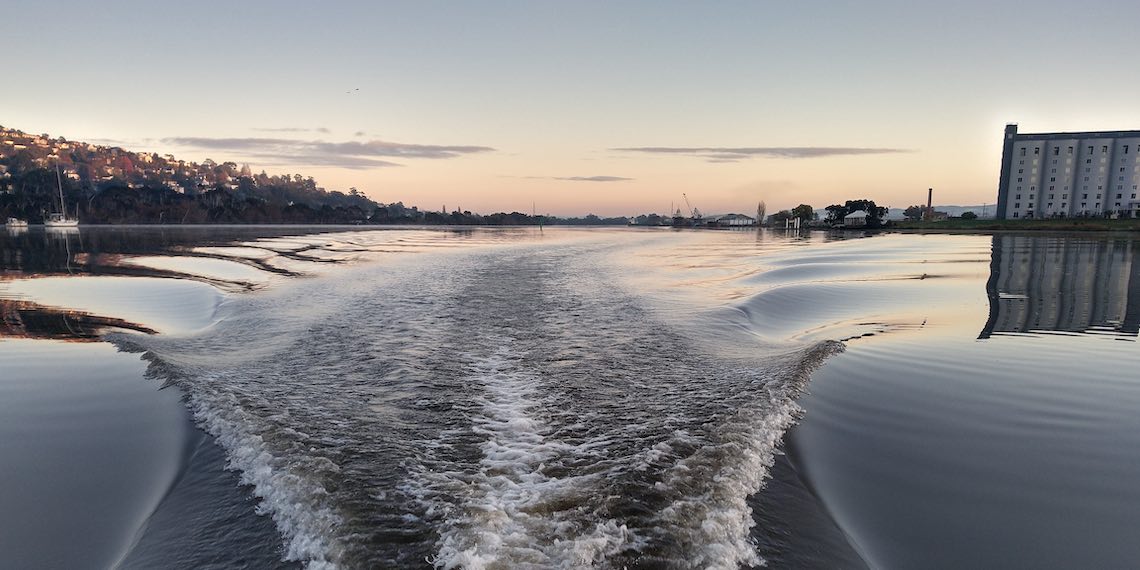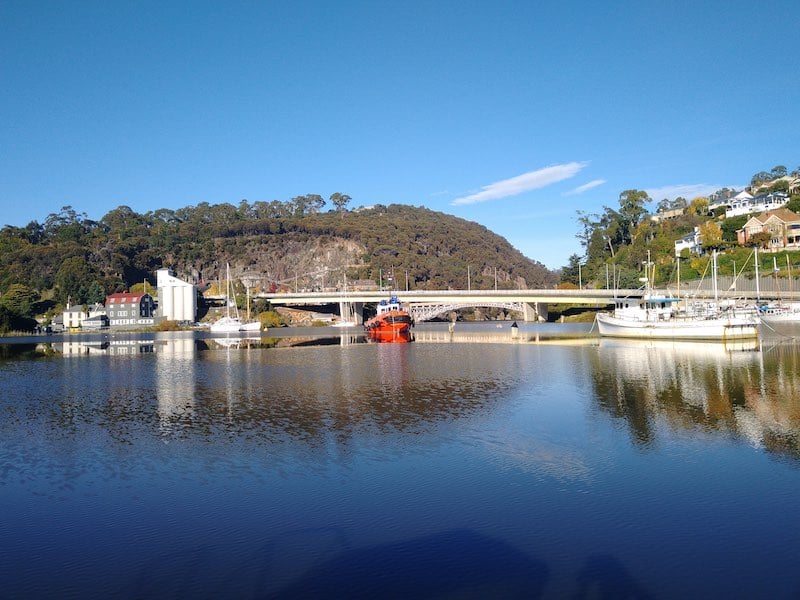Our Water Stories: working together for healthy waterways from ‘catchment to coast’

For the past 15 years, natural resource management agency NRM North has been involved in coordinating the protection and management of the iconic kanamaluka/Tamar estuary via a regional partnership program – a water story that has been about working together to protect one of northern Tasmania’s most important natural assets.
The City of Launceston and surrounding Tamar Valley is dissected by the waterway, which, at 70 km, is Australia’s longest navigable estuary and carries the combined flows from an area of more than 10,000 km2, including five major river systems.
“The estuary underpins the social and economic values of the region and is an essential asset for the provision of clean drinking water, primary industries and recreational amenity,” Tamar Estuary and Esk Rivers (TEER) Program Manager Darren McPhee said.
“It is also ranked as the second most biodiverse estuary in Tasmania and is home to a wide range of plant and animal species, including international recognition as an important bird area.”
But the upper reaches of the estuary have come under pressure from human impacts, such as diffuse and point source pollutants, including nutrients, sediments, metals and pathogens.

Established in 2008, the Tamar Estuary and Esk Rivers (TEER) Program is a regional partnership between the agencies responsible for management of the kanamaluka/Tamar estuary and Esk Rivers, McPhee said.
“Bringing together multiple jurisdictions and responsible agencies, the role of the program is to improve understanding of the issues impacting waterway health to better identify and target priority areas requiring on-ground action,” he said.
“With more than 18 partner organisations responsible for managing the catchment, including state and local government, industry and scientific groups, the program has an important role in coordinating and improving knowledge and management to improve waterway health.”
Data for health
The TEER Program has one of the longest ongoing water quality data series for a major waterway in Tasmania, which can be used to assess current ecosystem health as well as the long-term trends in water quality in the kanamaluka/Tamar estuary, McPhee said.
“Beginning in 2009, the TEER Program now has over a decade of data that can be used to inform evidence-based management and investment to protect and enhance this iconic waterway,” he said.
“Building on the water quality monitoring data, the TEER Program developed a Water Quality Improvement Plan in 2015, which was the foundational blueprint for improving water quality throughout the catchment.”
McPhee said catchment and estuary modelling was used to develop an understanding of current pollutant loads and sources of pollutants, and related pressures and opportunities of land use change.
“Extensive engagement and scenario testing with the community and key stakeholders informed an assessment of feasible changes in management practices, and likely adoption rates, which refined the load and condition targets and recommended management actions that would achieve improvements in water quality in the kanamaluka/Tamar estuary,” he said.
Two years later in 2017, these targets for reducing pollutant loads and improving water quality in the estuary were used to inform the Tamar Estuary River Health Action Plan (RHAP) as an investment plan for improving public health outcomes in the upper kanamaluka/Tamar estuary.
Plan for action
NRM North Water Program Manager Jesse Webster said the Tamar Estuary Management Taskforce (TEMT), led by the Tasmanian Government, developed the River Health Action Plan to guide significant investment in water quality improvement.
“Funding for the River Health Action Plan was secured in 2018 from the Tasmanian and Australian Governments to improve the health of the kanamaluka/Tamar estuary, by reducing pathogen concentrations in the upper estuary – Launceston to Legana – by almost 40%,” he said.
“This will be achieved through upgrades to Launceston’s combined sewer and stormwater system – about 35% – and a catchment works program – 4.7%.”
The improvements in the combined sewer and stormwater network involve significant upgrades to network infrastructure, which is being managed by TasWater and the City of Launceston.
Actions to reduce diffuse sources of pathogens from the catchment are being managed by NRM North in partnership with the City of Launceston, DairyTas and Tasmanian Farmers and Graziers Association.
“This is achieved through a rural component – the Tamar Action Grants, and an urban component – the Sewage Intrusion Program,” Webster said.
“The aim of the Sewage Intrusion Program was to identify incorrectly plumbed sewerage infrastructure that is connected to the separated stormwater system across greater Launceston.
“Cross-connections of sewerage pipes into the separated stormwater system result in untreated sewage discharging directly into the estuary, which carries pathogens and has implications for public health.”
Through the program, 44 sewage intrusions were identified and rectified across greater Launceston’s separated stormwater system, estimated to prevent 13.2 megalitre per annum of untreated sewage from entering the estuary – the equivalent of 5.3 Olympic-sized swimming pools each year.
“The rural component, the Tamar Action Grants (TAGs), assists grazing and dairy farmers in the Meander, North Esk, South Esk, Brumbys-Lake, Macquarie and Tamar catchments to improve waterway health by restricting stock access to waterways and reducing effluent runoff,” Webster said.
“Since its inception in 2019, TAGs have attracted significant interest from the agricultural community, with many landholders motivated by their own land stewardship goals to improve water quality, reduce streamside erosion, and rehabilitate riparian areas.”
As of June 2022, TAGs have: facilitated 140 landholders in planning and implementing water quality improvement projects; contracted 546 km and completed 352 km of livestock exclusion fencing; and protected 1489 hectares of streamside riparian area.
The TAG program has also contracted 2986 hectares of dairy milking platform for improved effluent management; and will exclude an estimated 222,200 sheep, 18,600 cattle and 7500 dairy cows from waterways at the completion of all contracted works.
“While the overriding objective of the TAG program is to reduce pathogen concentrations in the estuary, the reason for doing so varies greatly between grant recipients,” Webster said.
“For Gordon Bayles from ‘Little Forest’ near Cressy, the grant has enabled him to install 1.5 km of fencing on his grazing property, and he said the main benefit was improved water quality and improving the riparian area.
“But the flow-on effect from improved water quality is far reaching. At Will Green’s farm near Cressy, on-ground works to exclude stock from 4 km of watercourse, have improved habitat for one of the most threatened native freshwater fish species in Tasmania – the swan galaxias.”
Webster said the contribution of community funding toward projects like these allows landholders to achieve environmental outcomes that not only benefit the broader community, but hold significant personal value to the landholder as stewards of the land.
“It is important for landholders involved in the Tamar Action Grants that the community is aware of the value they place on looking after waterways on their properties,” he said.
Funding recipient Bill Gibson has completed stock exclusion fencing, which has protected an impressive 11 hectares of riparian zone.
“The Tamar Action Grants is a good opportunity to collaborate and to hurry along environmental protection. It is an important development for the public to know that farmers are interested in the protection of the environment,” he said.
“I am much encouraged by the support from the grant.”
The program is supported with funding provided by the state and federal governments through the Launceston City Deal and the Australian Government’s Tamar Estuary River Health Grant.


